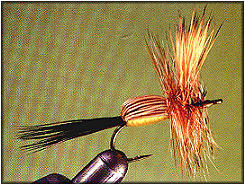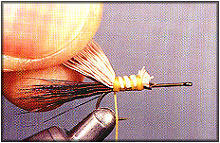|
The Humpy
The Humpy seems to have established itself as the number-one rough-water
dry fly. Its hair hump adds buoyancy, and the tips of the fibers that form
this hump make the wings. Clever. I will show you a few unconventional
techniques for tying this fly that make it quick to tie and durable.
In The Second Fly Tyer's Almanac, Kathy Buckner
gives an excellent description-demonstration of tying the Humpy. She states
that "The key to the whole thing is the length of the tail," and says that "If
the tail is the right length, everything else will come out right." That's true,
because all the critical measurements come from the tail.
Here are a few pointers for tying the Humpy that I have discovered on my
own: Elk hair is the best for the humpy's hump and wings - elk hair is
generally much tougher than deer, and the hump is secured at both ends
which makes it vulnerable between. Determine the thickness of the hump-wing
hair bunch to suit the wings; don't worry about the hump. Again, careful
measuring of the tail and wing-hump hair is critical . . .but even when
measuring is done carefully, variations in hook design will vary the length
of the wings somewhat, though not to any real consequence.
Single-strand floss used as thread for the first few steps will make
the Humpy go quickly - the floss covers the hair much faster than would
any thread, and the floss's strength allows you to really secure the hair. When
drawing the hump-wing hair up and forward, stroke you grasp up the hairs
to even out tension amoung them.
I have developed my own style for tying the Humpy, but that style was formed
from Kathy's insight. ~ Skip Morris
Materials List:
Hook: Standard dry fly, sizes 18 to 10 (the hook
shown is a Tiemco 101).
Thread: Single-strand floss and 8/0, 6/0 or 3/0
thread (both floss and thread should be the same color; colors include
yellow, red, black, orange, green, and fluorescent versions of these
colors).
Tail: Moose-body hairs.
Hump, and Wings: Natural elk hair.
Hackle: One grizzly and one brown.
|







